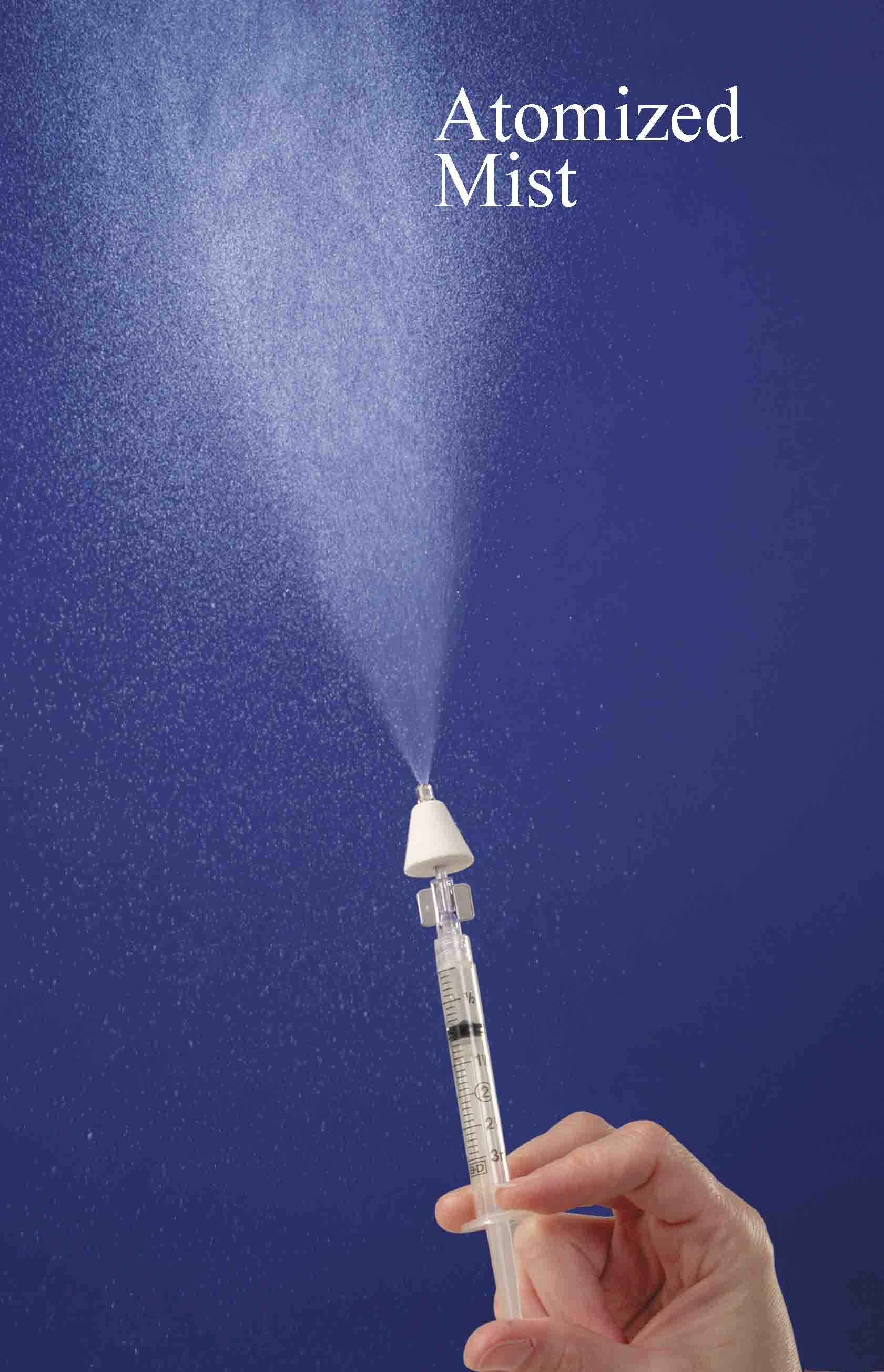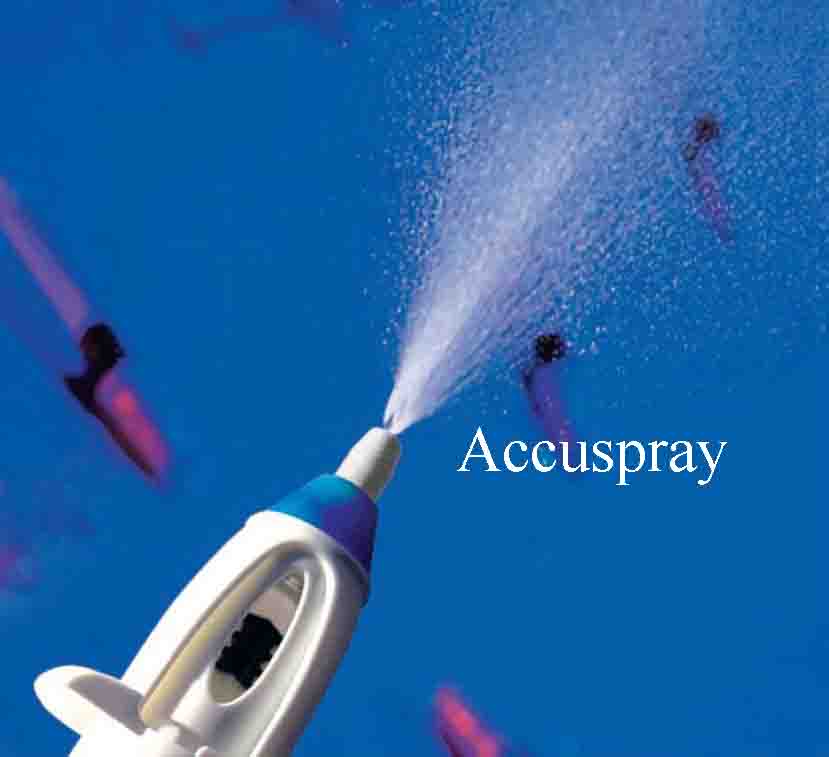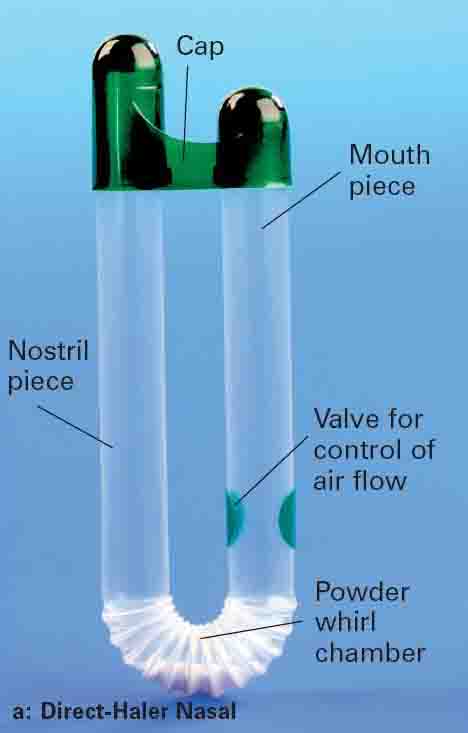Nasal drug delivery techniques
Table of Contents:
Method of nasal medication delivery (click here)
Usability - functionality problem with drops (click here)
Commercially Available Delivery systems (click here)
Recommendations to enhance success with nasal drug delivery (click here)
How should one deliver medications to the nose?
Snorting
The method of intranasal medication delivery likely impacts the success of the procedure. Elicit drug users employ a technique called “snorting” whereby they take a highly concentrated powder form of a drug such as cocaine or heroin and rapidly sniff the drug into the nostril. This causes deposition of the powder onto the nasal mucosa and rapid transfer of the drug into the circulation and brain. This technique requires an experienced and cooperative user and is unlikely to be effective in medical therapeutic situations.
Drug delivery as drops using a syringe or dropper
A second method of intranasal drug delivery is to take a solubilized medication (liquid form) and drip it into the nose a few drops at a time, allowing it to run down onto the nasal mucosa. This can be done using a syringe or in some instances using the packaged form of the medication to drip it directly into the nose. To use this technique, most generic medications will need to be removed from within their storage bottle using a syringe. The syringe can then act as the measuring/dosing device as well as the dropper. The efficacy of the nasal dropper techniques varies depending on which author you read. Some authors find drops to be an effective method of delivery,[1-3,20] while others note poor surface area coverage and rapid removal of the medication into the throat via runoff and ciliary movement.[1, 4-10] Patient compliance and head position are also crucial for success - if the patient refuses the drops or fails to hold their head in the best position, much of the drug is either not delivered or lost to the external environment or into the throat.[14-16] Never the less it is this method has been used in many research studies and found to be an effective method of delivering adequate doses of medication to cooperative patients when they hold their heads in the proper position to prevent excess run-off.
Enhancing nasal drug delivery using drops - position the head properly [15-17]
In 2013 Habib compared two of the above positions (a) - lying head back and (b) head down forward using a mucosal atomization device for the delivery of fluorescein spray.[19] They found markedly improved coverage of the mucosa (76% vs. 44%) with coverage of the areas of the ethmoid, frontal and sphenoid sinuses particularity improved. they feel these findings are of particular clinical importance. (And if you wish to enhance nose-brain pathway delivery, getting drug high into the sphenoid sinuses is important.
Usability problems with drops
Unfortunately, outside the research arena there are some issues regarding the “usability” of the nasal dropper technique. Usability is a term that evaluates the human-technological interface to assess how easy a technology is to master and use. Usability also includes an evaluation of efficacy (did it work) and satisfaction (did I like using it or was it very difficult to use). A good idea that is difficult to apply will rarely be adopted outside the research setting. While mastering the concept of using a syringe as a dropper is very simple, the actual application in a clinical environment is less straight forward and can lead to delivery failure, drug failure and clinician/patient abandonment of the technique due to low satisfaction. Unfortunately, nasal dropper delivery of medications requires a fairly cooperative patient or actual physical restraint of the patient to position them in a semi-recumbent or other unusual position (usually requiring at least two adults to hold in position) so the medicine will run back into the nose and not out onto their lip or throat. Drops delivered too rapidly cause the drug to run straight through into their throat leading to coughing, gagging and poor absorption. In fact, laying flat on back and dripping the drug into the nose is a poor way to achieve good bioavailability and should not be used.[17] It is better to have them position themselves as shown in the above diagram. Drops delivered slowly also often require prolonged restraint in any but the most cooperative patient. It is also very common for the uncooperative patient to violently blow their nose at the time of delivery – expelling the drug externally into the environment and onto the clinician. It is possible that these usability issues have contributed to the delayed adoption of intranasal drug delivery in the medical community despite over 20 years of research demonstrating how effective intranasal medications can be in selected situations.
Syringe dropper "technique"

Squeeze bottle delivery
Squeeze bottle delivery is another option for nasal drug delivery. However this technique is not able to deliver a measure dose of drug. Mucosal coverage is also dependent on the patient applying adequate pressure to the device to deliver the drug - so delivery is very variable. Finally, following bottle squeezing, external materials on the bottle tip are sucked back into the medication container - contaminating it for any further use.[14, 17]
Sprayed or atomized medication delivery
Sprayed or atomized intranasal medication delivery is a more recent technique adopted by the pharmaceutical industry due to improved usability issues as well as improved bioavailability data. This delivery technique combines a method of measuring a unit dose of medication – either via a syringe or unit dose pump – with a spray tip that fragments the medication into fine particles as it is being sprayed into the nose. It appears that this method of delivery results in a broader distribution of the medication across the nasal mucosa and an increased bioavailability of the drug. [1, 4-7, 9-12, 22] Furthermore, the usability issue makes this nasal spraying of medications far easier to employ – the patient can have the medication delivered from any position (sitting, lying down, prone, on side) and since it only takes a second to administer the dose they do not need to be restrained. Finally, because the medication is sprayed/atomized as a mist, less is likely to be blown back out the nose into the external environment. For all these reasons, most pharmaceutical nasal medications are now packaged with a spray applicator rather than a dropper. In addition, syringe driven and pump driven spraying devices (atomizers) now exist for delivery of a variety of generic nasal medications. Researchers have found that single-unit dose sprays is the optimal way of enhancing mucosal coverage - superior to pump spray bottle delivery techniques.[15-17] Other researchers have noted that properly aerosolized particles delivered to the olfactory mucosa markedly improve time to onset and analgesic efficacy (as well as brain tissue concentrations) of opiates when compared to nasal drops - further supporting the importance of the type of delivery system used to provide nasal drugs.[18]
Plasma concentrations of drug when delivered via atomized spray or drop - showing the superiority of the spray technique [17]
Click here for an extensive review of nasal drug delivery techniques: http://dare.uva.nl/document/18441
Atomized mist demonstrating small diffuse particles:
Pediatric IN drug delivery photo high resolution for download (4 MB)
Types of Delivery Devices available for intranasal medication delivery:
Prefilled syringes of medication:
One of the potential downsides to seeing intranasal drug delivery achieve its real therapeutic potential (use by pay public and BLS provides in time dependent emergencies such as seizures and opiate overdose) has been the need to draw up the proper dose of a drug into a syringe. While this is a routine task for experienced medical providers, it adds a difficult step for less experienced personnel and may be just difficult enough that they prefer to use less effective methods such as rectal or buccal medications. However - that problem is easily solved if the drug is purchased prepackaged in a graduated syringe that can attach to an atomizer. The dose is easily determined by the graduations. In situations such as home use of midazolam or lorazepam for seizures where the entire volume might not be appropriate, the syringe can have a indelible mark or piece of tape applied by the clinician or pharmacy at the appropriate dosage so the parent/provider knows how much to give. Just be sure to purchase the proper dosing (concentrated).
Carpuject of midazolam (has a Luer attachment for a needle or atomizer)

Based on extensive research and community use, this prepackaged midazolam in the 5mg/ml dosing would certainly seem appropriate for use by properly trained families and BLS providers - and this packaging would surely help improve the ease of use. See this PDF file for the information on other prepackaged medications: Carpuject medications
Accuspray Nasal Atomizer:
Direct-Haler powdered drug nasal delivery:
Go-Pump:

MAD (Mucosal Atomization Device) nasal:
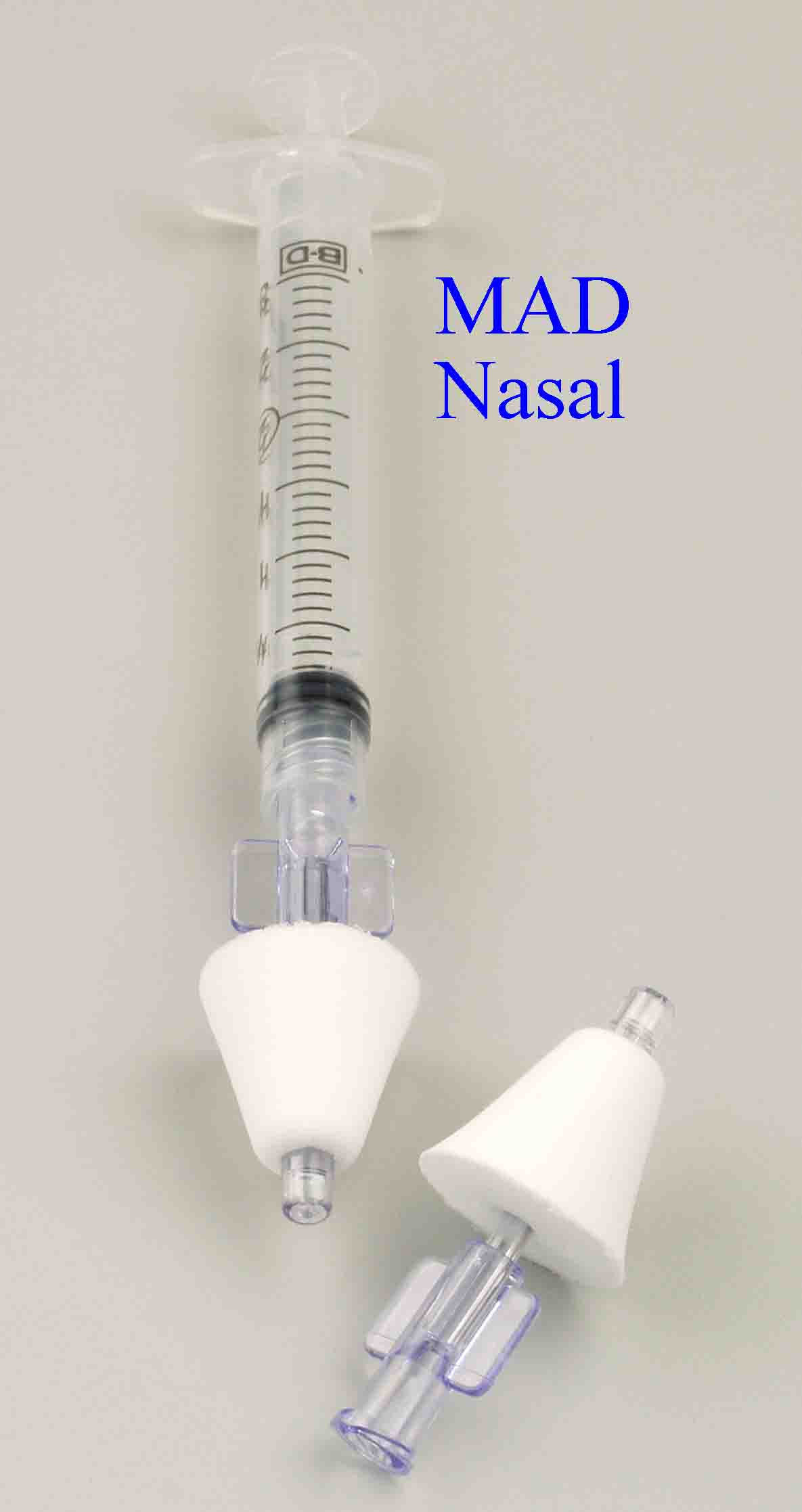
Versidoser

Optinose:
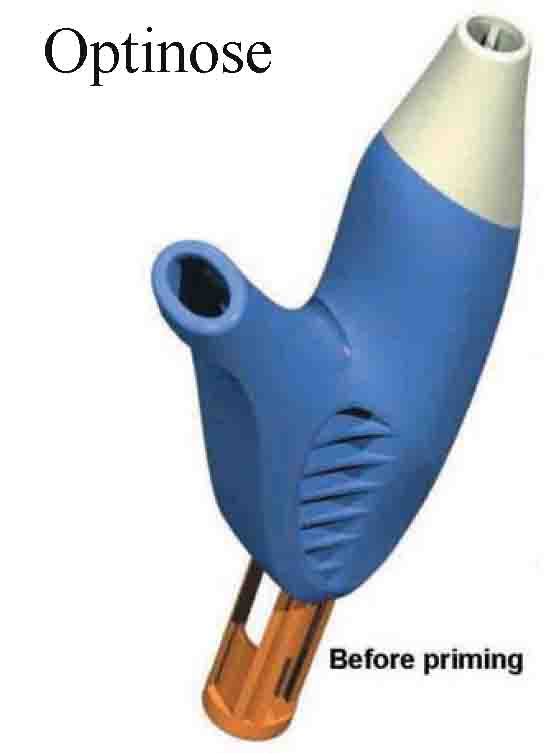
ViaNase Electronic atomizer
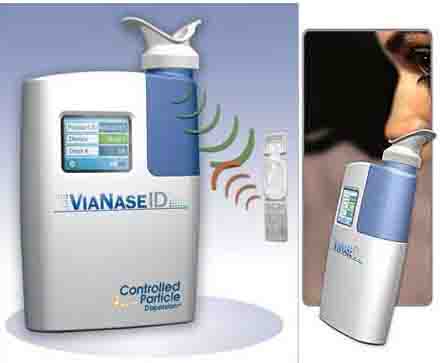
"Nebu-Laser" home made system by Whit Fisher, MD
Here is a home made system that uses a couple of nebulizers dis-assembled and reconfigured to allow you to "atomize/nebulize" a drug into the nose or throat. Visit his video sequence at this link to visualize the device in action: http://www.procedurettes.com/Procedurettes/Nebu-laser.html
Nebulized versus atomized
Occasionally you will find articles touting nebulized medications as a method to delivery systemic drugs. While the lung has a large absorptive surface area, there are several problems with this delivery method for routine systemic and CNS delivery of drugs. First, nebulizers deliver very little drug to the actual target tissue (the lung) - most is lost into the environment, some to the relatively non-absorptive tissue between the oral opening and the alveoli and very little actually reaches the end destination. More concerning is the unknown toxicity. While a drug that irritate the nasal mucosa is not optimal, it is also probably not outright dangerous especially if used on occasion. A drug that damages lung tissue is an entirely different matter and practitioners should be hesitant to deliver a drug to the pulmonary tissue until and unless they are sure it is safe. Finally - and certainly of significant importance to most of the indications discussed for nasal drug delivery on this web site is the length of time it takes to nebulize a medication (many minutes) to the time it takes to atomize the same volume (1-2 seconds). Last of all - the little literature that does exist on the topic shows far higher serum levels and or superior clinical efficacy when the same drug is given via the nasal mucosal as via nebulizer as demonstrated by the graph below comparing nasal vs. nebulized midazolam[13,21]:
Regardless of the method chosen to deliver a nasal medication, several suggestions are worth mentioning:
-
Use a highly concentrated form of the medication to reduce volume and therefore reduce runoff. ¼ to 1/3 ml per nostril would be preferred. 1/2 to 1 ml per nostril is tolerable but there will be some loss as the volume increases. More than one ml per nostril per dose should likely be split and delivered over several cycles separated by 10-15 minutes.
-
Always use a method that allows the delivery of a measured dose (syringe or unit dose pump)
-
Use a method that fragments the medication into fine particles so the maximal nasal mucosal surface is covered and minimal volume runs out the nose or into the throat (atomizer for liquid, powder needs to be well distributed)
-
Utilize both nostrils to double the surface area for absorption and halve the volume delivered per nostril
-
Be knowledgeable of the “dead space” within the delivery device and account for this dead space when calculating the volume you will deliver to the patient
Bibliography (Click here for abstracts)
1. Hardy, J.G., S.W. Lee, and C.G. Wilson, Intranasal drug delivery by spray and drops. J Pharm Pharmacol, 1985. 37(5): p. 294-7.
2. Aoki, F.Y. and J.C. Crowley, Distribution and removal of human serum albumin-technetium 99m instilled intranasally. Br J Clin Pharmacol, 1976. 3(5): p. 869-78.
3. Tsikoudas, A. and J.J. Homer, The delivery of topical nasal sprays and drops to the middle meatus: a semiquantitative analysis. Clin Otolaryngol, 2001. 26(4): p. 294-7.
4. Chien, Y.W., K.S.E. Su, and S.F. Chang, Chapeter 3: Physicochemical, biopharmaceutical, and toxicophysiological considerations. Nasal Systemic Drug Delivery,, 1989. Dekker, New York: p. 39-90.
5. Mygind, N., Nasal Allergy, 2nd edition. Blackwell, Oxford, England, 1979: p. 257-270.
6. Mygind, N. and S. Vesterhauge, Aerosol distribution in the nose. Rhinology, 1978. 16(2): p. 79-88.
7. Bryant, M.L., et al., Comparison of the clearance of radiolabelled nose drops and nasal spray as mucosally delivered vaccine. Nucl Med Commun, 1999. 20(2): p. 171-4.
8. Daley-Yates, P.T. and R.C. Baker, Systemic bioavailability of fluticasone propionate administered as nasal drops and aqueous nasal spray formulations. Br J Clin Pharmacol, 2001. 51(1): p. 103-5.
9. David, G.F., C.P. Puri, and T.C. Anand Kumar, Bioavailability of progesterone enhanced by intranasal spraying. Experientia, 1981. 37(5): p. 533-4.
10. Henry, R.J., et al., A pharmacokinetic study of midazolam in dogs: nasal drop vs. atomizer administration. Pediatr Dent, 1998. 20(5): p. 321-6.
11. Harris, A.S., et al., Effect of viscosity on particle size, deposition, and clearance of nasal delivery systems containing desmopressin. J Pharm Sci, 1988. 77(5): p. 405-8.
12. Bjorkman, S., G. Rigemar, and J. Idvall, Pharmacokinetics of midazolam given as an intranasal spray to adult surgical patients. Br J Anaesth, 1997. 79(5): p. 575-80.
13. McCormick, A. S., V. L. Thomas, et al. (2008). "Plasma concentrations and sedation scores after nebulized and intranasal midazolam in healthy volunteers." Br J Anaesth 100(5): 631-6.
14. Bommer, R., Latest advances in nasal drug-delivery technology. Med Device Technol, 1999. 10(4): p. 22-8.
15. Merkus, P., et al., Influence of anatomy and head position on intranasal drug deposition. Eur Arch Otorhinolaryngol, 2006. 263(9): p. 827-32.
16. Merkus, P., et al., The 'best method' of topical nasal drug delivery: comparison of seven techniques. Rhinology, 2006. 44(2): p. 102-7.
17. Merkus, P., Current aspects of nasal drug delivery. Thesis - University of Amsterdam, 2006: p. http://dare.uva.nl/document/18441.
18.
Hoekman, J.D. and R.J. Ho, Enhanced analgesic responses after preferential delivery of morphine and fentanyl to the olfactory epithelium in rats. Anesth Analg, 2011. 113(3): p. 641-51.19. Habib, A. R., A. Thamboo,
et al. (2013). "The effect of head position on the distribution of
topical nasal medication using the Mucosal Atomization Device: a cadaver
study." Int Forum Allergy Rhinol 3(12): 958-962.
20.
Li, B. L., N. Zhang, et al. (2016). "A comparison of intranasal
dexmedetomidine for sedation in children administered either by atomiser
or by drops." Anaesthesia
71(5): 522-528.
21.
Singh, R., A. Pareek, et al. (2016). "Post-operative analgesic efficacy
of fentanyl via different routes – A comparative study of nebulisation,
intranasal and intravenous routes." IAIM
3(6): 16-22.
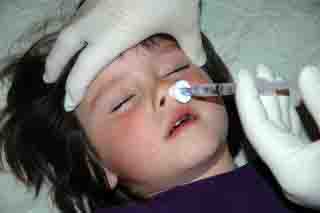 Therapeutic
Intranasal Drug Delivery
Therapeutic
Intranasal Drug Delivery